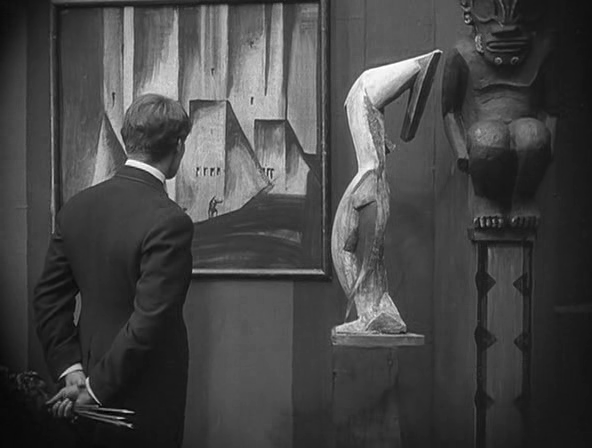Dr. Mabuse the Gambler (1922)
Fritz Lang's "Dr. Mabuse the Gambler"
Fritz Lang's 1922 film "Dr. Mabuse the Gambler" offers a look at a dystopian German society that emerged after the First World War. Due to the difficult conditions, Germany had dramatic swings in the stock market, overflowing gambling parlors, and miserable living conditions for the poorer communities. With the protagonist, Dr. Mabuse, Lang depicts a man of his own time trying to navigate the chaos in order to allow himself to prosper.
The film's protagonist, Dr. Mabuse, employs devious schemes to gain power in a society full of lawlessness, gambling, hyperinflation, frivolity, and chaos. Using disguises and hypnosis, as well as an assortment of henchmen, Mabuse amasses a fortune through gambling and murdering. Though he is careful to cover his tracks, a resourceful police inspector, Norbert von Wenk, remains determined to capture him.
The title of the film, Dr. Mabuse der Spieler, makes use of three meanings for the German world 'Spieler.' It can mean gambler, puppeteer, or actor. Dr. Mabuse enables all three meanings, as he gambles, dresses in disguises, and manipulates people like puppets. When speaking with a countess, Mabuse gives reason for his actions. He states that he is trying to gain power and does so by gambling with people's lives. He manipulates the stock market, hypnotizes people into gambling away their money, and makes various arrangements to disrupt the lives of everyone around him. According to Lang scholar Paul Jensen, the character of Mabuse can be seen as a depiction of the inner psyche of the German people, a "symbol to unite all the negative factors in Germany at the time."
The film was a depiction of Germany in a time of chaos and prophesied what was to come. The dissolution of society itself was a major theme of the film. In the film, Mabuse creates worthless counterfeit money. This mirrored the nearly worthless Deutsche Mark during the hyperinflation of the country after the war. This led the Weimar Republic to print excess money to pay war reparations. Because of the nearly absent value of German money, the country was facing economic peril. Because of the financial and social uncertainties, the climate gave way to an impoverished lower class and a panicked faux decadence of the higher class. This not only led to an almost absence of law and order, but caused incredible spikes in wealthier citizens gambling and being flagrant with their currency. Lang depicts this flagrancy through gambling halls, nightclub strip shows, mindless stage entertainment, heavy social intoxication, and an overindulgence in decadence. The interiors of these nightclubs are incredibly expressionist in their display by Lang - the interiors of the decadent nightclubs and homes of its wealthy participants are full of Art Deco, mock Cubist canvases, and faux African sculptures. Kevin Hagopian of Penn State University states, "the shimmering decadence of Weimar masked the terrible uncertainty about whether - and how - the authoritarian past of the nation would reassert itself. Perhaps no other film from this distinguished epoch in film history so deftly captures the heady mix of thrills and impending darkness[.] What claims to be a melodrama of a mysterious professional gambler is in fact an allegory for a Germany that was just as mysterious to itself, tragically impelled to move from anarchy through democracy to fascism." Hagopian also adds that "murder, sex, jazz, idle aristocracy, sensual nightlife, insanity, psychoanalysis, magic, hallucinations, spiritualism, quackery, drugs, bizarre medical experiments, elegant gambling halls, and sumptuous city skylines pierced by rays of light and pounding with the insistent pulse of the contemporary, [the film] is an intoxicating modernist nightmare." Emerging out of this insanity was Dr. Mabuse himself. Dr. Mabuse uses the chaos of the fever-dream nightmare Germany was living in to gain control and power. This prophetically aligned with the real-world results of this hellish time, as Adolf Hitler and the Nazi Party took advantage of the economic and social chaos that was left in the wake of the collapsed aristocracy. It is in this way that Lang views his protagonist as inevitable. Lang has often described Mabuse as a Nietzschean Ubermench - as he presents himself as a savior, an antidote to disorder. He presents himself as a working medical professional, the psychoanalyst, but beneath the surface manipulates people's money and lives to enrich his own power. The film presents Mabuse as a byproduct of the corrupt society he lives in, with no other choice but to make authoritarian order out of the chaos. Frankfurt School analyst Siegfried Kracauer argues that as the ashes of World War II was settled, Dr. Mabuse the Gambler, in retrospect, was concrete evidence of the growing influence of the authoritarian personality in German life during the political Indian summer of Weimar. This personality is a direct result of the dystopia depicted in the film.
The art decadence presented in the film.







Comments
Post a Comment